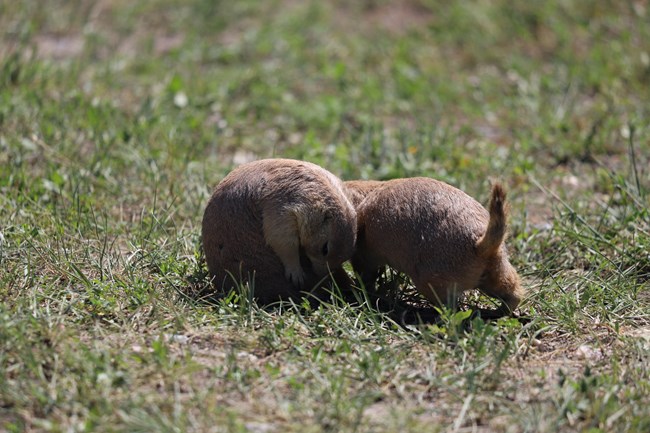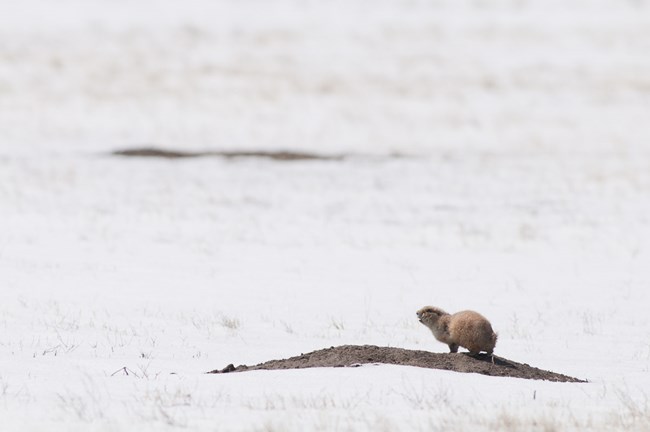Part of a series of articles titled Wildlife in the Badlands.
Article
Prairie Dogs: Pipsqueaks of the Prairie

Badlands National Park / NPS Photo

Badlands National Park // NPS Photo
What is a prairie dog?
Prairie dogs are members of the Scuiridae (squirrel) family and are related to other members of the Scuiridae family like ground squirrels and chipmunks, both of which live in Badlands National Park. The prairie dog species found in the Badlands is the black-tailed prairie dog, which also happens to be the most common prairie dog species overall.
Prairie dogs tend to be around 14-17 inches in length and weigh 1-3 pounds each. Some of their bodily adaptations have made them excellent at what they do. Their short, strong arms and long-nailed toes help them to dig burrows. Although their legs are short, prairie dogs can run up to 35 mph at short distances to escape predators for the safety of their burrows.
Once-Plentiful
Prairie dogs were once a major part of the American landscape. Their original range stretched from Canada to Mexico and it is estimated that before 1800, over 5 billion prairie dogs roamed the American plains. Today, the original range of prairie dogs has shrunk to just 5% of its initial size and two of the total five prairie dog species in existence are threatened or endangered. But why?
In the 1800s, white settlers expanded into the American west, a home to countless forms of wildlife and to the many Native Americans who lived in the west for several generations. Due to the Homesteading Act and Dawes Act, much of the land settled by Euro-Americans was put towards agriculture and ranching. This land use change was for the worse when it came to prairie dogs.
As settlers began ranching in the west, prairie dogs were viewed with hostility. Prairie dogs were considered a carrier of disease that competed with cattle for forage, ruining grazing areas. We now know these assumptions to be untrue. Modern studies tell us that prairie dogs are killed so quickly by disease that they aren’t a viable disease-carrier and that prairie dogs cannot consume enough grass to be considered as forage competitors with cattle. This was not common knowledge at the time of westward expansion, and there was a rapid decrease in prairie dog numbers. Regarded as vermin, settlers killed prairie dogs in large quantities with poison and by recreational shooting.
Prairie Dog Colonies
Prairie dogs live in underground colonies sometimes referred to as “towns,” like Robert’s Prairie Dog Town on Badlands Loop Road. Prairie dogs build their homes underground to protect against predation and flash flooding. These colonies can be massive, with the largest ever recorded prairie dog town encompassing 25,000 square miles – an area greater than the state of West Virginia. However big a prairie dog town may be, it is likely to be equally as complex. Prairie dog towns are divided up into different units with different purposes.
A coterie is a unit of a prairie dog town encompassing about 1 acre. A coterie typically has 50-60 entrance points and belongs to a single family of prairie dogs, including an adult male, many adult females, and their offspring. Members of the same coterie will kiss or sniff upon identifying each other. Prairie dog towns may also include side chambers for use as a sleeping space or storage room and back doors for extra escape routes.

Badlands National Park // NPS Photo
A Day in the Life of a Prairie Dog
A prairie dog’s life includes many different activities. Their days are typically spent eating, keeping an eye out for predators, building new burrows, or maintaining existing ones.
Prairie dogs tend to eat plants but may munch on insects occasionally. Prairie dogs vary their diet, so they aren’t reliant on a single plant for survival. When they eat the grasses around their town, many positive effects click into place. Trimmed grass helps increase visibility, allowing prairie dogs to detect predators more quickly. Additionally, when prairie dogs eat away at grass, they make new space for plants like forbs and weeds. Prairie dogs will eat forbs in addition to their frequent diet of grass, and the change in growth and plant type brings more grazers, like bison and pronghorn, to prairie dog towns.
As the winter approaches, prairie dogs eat more and more food to fatten up for the colder season. Although they fatten up, prairie dogs don’t hibernate for the winter. Instead, they will go into a state of torpor. In torpor, an animal’s body temperature, breathing rate, and metabolic rate all decrease. The animal becomes lethargic, but unlike a hibernating animal, is still awake. Although prairie dogs are in a state of torpor, the activities of prairie dog towns remain slow but normal throughout the winter season.
When spring comes around, prairie dogs come out of torpor and resume their typical activities. Starting in March and continuing through early April, prairie dogs mate. The gestation period for a prairie dog is just one month, and when prairie dogs give birth, they usually do so in litters of 1-6. Pups are born blind and hairless. Pups stay underground in their coterie for about 6 weeks, until they are ready to emerge from their burrows.
One unique aspect of prairie dog life is communication. Some scientists believe that prairie dogs have one of the most complex animal languages ever decoded. Although a prairie dog’s “bark” may sound like a simple squeak or yip to us, it means much more to a prairie dog’s ear! On a basic level, prairie dogs can signal different threats. For example, they can communicate the difference between a coyote and a domestic dog. In fact, scientists think that prairie dogs may have developed such complex language from a need to respond to a diverse array of predators, all with different hunting strategies. In addition to identifying specific threats, prairie dogs can further communicate size, shape, color, and speed. A prairie dog can say so much more than, “A human is approaching!” They can get as specific as, “A tall human in a blue shirt is approaching rapidly!”

Badlands National Park // NPS Photo
Why are prairie dogs important?
Prairie dogs are a keystone species. A keystone species is one that many other species, both plant and animal, depend upon for survival. Keystone species are incredibly important to their ecosystems, and if removed, the ecosystem itself may collapse. Prairie dogs serve as a prairie keystone species by getting eaten, making homes for other animals, clipping vegetation, and much more.
Prairie dogs are a major target as prey. Many different animals eat then due to their small size. The Badlands is home to several different predators of prairie dogs: coyotes, bobcats, badgers, foxes, rattlesnakes, and birds of prey. Another important prairie dog predator which calls the Badlands its home is the black-footed ferret, one of the most endangered species in North America. Black-footed ferrets eat prairie dogs exclusively.
Prairie dogs are also considered a keystone species because of the burrowing networks they build. These burrows, of course, protect prairie dogs from natural dangers like predators and flash flooding, but they also work as a miniature apartment complex. Many animals call prairie dog towns home! One Badlands animal that lives in these towns is the burrowing owl, which makes its nests and homes in abandoned prairie dog dwellings. Rattlesnakes will also take up residence in prairie dog burrows for the winter when they enter a period of inactivity called brumation.
Prairie dogs also have major effects on plant life. As prairie dogs clip away grasses, there’s more room for forbs and weedy plants to grow. Additionally, the constant trimming of vegetation contributes to growth that is higher in nutritional quality. This means that prairie dogs and other grazers like bison, bighorn sheep, and pronghorn all benefit from a prairie dog’s work of trimming the grass around its town. This clearing also increases visibility in and around colonies, which attracts grassland birds looking for easy hunting grounds.
Threats to Prairie Dog Populations
Despite being a keystone species, prairie dog populations face many dangers – some of which extend far beyond the watchful eyes of predators. Climatic changes could affect the plant life surrounding prairie dog towns. Changes in the availability of edible plants could mean starvation. Food is also important in the instance of overcrowding – if prairie dogs can’t access ample space for their colony, they risk overcrowding. With overcrowding issues, starvation becomes a risk and disease can spread more quickly. Luckily, national parks like the Badlands allow colonies to spread within park boundaries, where prairie dogs should have plenty of room to expand.
Disease is a serious threat to prairie dog populations. In 1900, trade ships from Asia brought over rats which carried Yersinia pestis, bacterium which causes Sylvatic Plague. Sylvatic Plague is the name for the Black Death when it is found in animals. The plague is fast-traveling and can wipe out colonies in short periods of time – sometimes as low as a week. Sylvatic Plague became a problem for prairie dogs when it was brought here in the 1900s, and it’s a problem that persists in prairie dog populations today. In Badlands National Park, wildlife biologists attempt to prevent plague outbreaks by feeding our prairie dogs an oral vaccine. After testing out many flavors, they found that our prairie dogs like peanut butter best!
Prairie dogs face many challenges. Some, like predators, are immediately lethal, while others, like climatic changes, require more time to take effect. As a visitor to our park, we ask that you do not add to the list of challenges for prairie dogs. Please do not feed the prairie dogs. Prairie dogs have sensitive stomachs and cannot process human foods. Please do not attempt to touch or pet the prairie dogs. These animals can bite and many of them still carry the plague. For your health and for prairie dog health, please respect our prairie dog towns.
Last updated: November 10, 2020
